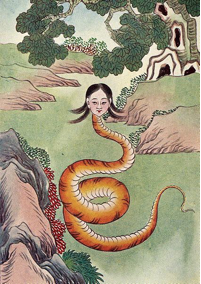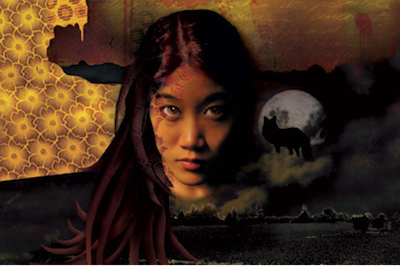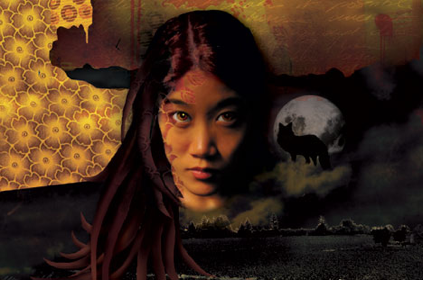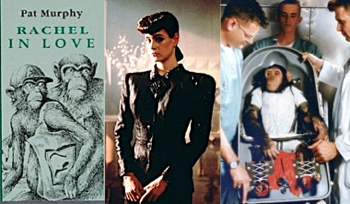Chinese-Canadian author Larissa Lai imaginatively interrogates the boundaries of the human, alchemizes myths of origin, and embraces the impurity of the cyborg while foregrounding the politics of racialization, animality, and sexuality. Lai builds on the rich tradition of women of color writing in sf/speculative fiction by splicing together cultural theory and current events with a panoply of intertexts. Traversing past, present, and future, Lai maps the permeability of the human through the vectors of animal, creator-goddess, cyborg, and transgenic procreation. Her distinctive métissage of Chinese legend, EuroAmerican culture, Orientalist archetypes, Western popular music, and science fiction disrupts cycles of institutionalized exploitation, corporatized amnesia, and multicultural assimilation.1Larissa Lai. “Future Asians: Migrant Speculations, Repressed History & Cyborg Hope.” West Coast Line. #44 (“West Coast Lai”: Special issue on Larissa Lai) 38, no. 2 (Fall 2004): p. 170.Akin to the work of Octavia Butler, Karen Tei Yamashita, and Nalo Hopkinson, Lai’s fiction and poetry expand “our sense of relation, our sense of community, with other human beings but also with the lifeworld that surrounds us…[to be] as rich, complicated and hopeful as it can possibly be.”2Larissa Lai, “BC Book Prizes: The Morning After.” April 25, 2010.Her “fictive histories of the present” craft a counterhegemonic site of belonging for minoritized, queer, polymorphous subjectivities and articulate a “new cultural politics of intimacy.”3Larissa Lai, Automaton Biographies. (Vancouver: Arsenal Pulp, 2009): p. 119
Lai’s first novel When Fox Is a Thousand (1995) introduces her project of sinicizing Adrienne Rich’s lesbian continuum. Lai uses the fox, a Chinese trickster figure, to illuminate “women’s alliances, sexual and otherwise…. there beneath the surface, between the lines.”4Larissa Lai, quoted in Ashok Mathur, “Interview with Larissa Lai July 1998.” (1998). http://www.angelfire.com/zine2/jungchiu/LaiLarissa.html. Accessed 6 June 2011.Crossing time and space, the fox “animates” the corpses of women in order to seduce other humans. One of fox’s favored bodies is that of Yu Hsuan-Chi/Yu Xuanji, a ninth century poetess-courtesan who was executed for murder. These legendary figures anchor Lai’s exploration of the politics of desire and seduction across temporalities and geographies. Embracing the fox’s reputation as a border-crossing “creature of darkness, death, germination, and sexuality” associated with the subterranean, the feminine, and the yin, Lai creates a symbol of “Asian women’s community and power” and an anti-racist “trope of lesbian representation.”5Larissa Lai, “Political Animals and the Body of History,” Canadian Literature 163. (Winter 1999): p. 151(see Figure 1)
Figure 1: Detail from cover art for When Fox Is a Thousand (2004) by Myron Campbell
In late twentieth-century Vancouver, Fox is drawn to Artemis Wong, a Chinese adoptee with Caucasian parents. Artemis’s viewing of Blade Runner (1982) subtly highlights cyberpunk’s techno-orientalism and feminist analyses of bioinformatics. The Asian-Canadian protagonist is subjected through multiple regimes of racialized and sexualized surveillance but lacks a vocabulary of resistance in a sanitized multiculturalism.6Lai, “Future Asians,” p. 168.The novel’s braiding of the narratives of Fox, Poetess, and Artemis index different kinds of erasure and alterity. This polyvocal structure enables “Lai to redefine both vision and storytelling as a multidimensional process” and to interrogate the fabrication and commodification of identity7Robyn Morris, “Looking through the Twin Lens of Race and Gender: a New Politics of Surveillance in Asian Australian and Asian Canadian Women’s Writing.” Ph.D. thesis. (2008): p. 143, 158. University of Wollongong Research Online. http://ro.uow.edu.au/783. Accessed 4 June 2011.
Oscillating between nineteenth-century China and a twenty-first century walled city in the Pacific Northwest, Lai’s second novel Salt Fish Girl (2002) constitutes a queer/feminist re-vision from a Chinese diasporic standpoint. The novel not only riffs off a diverse range of creation stories but also refracts 1990s headlines: Dolly the Sheep, maritime smuggling of Chinese migrants, Monsanto’s lawsuit against a farmer whose crop picked up genetically altered DNA, the patenting of modified basmati rice by a Texas corporation, and Disney’s construction of Celebration, “a fully planned ur-American town.”8Lai, “Future Asians,” p. 172.
Opening with the snake-woman deity Nu Wa (女媧), Salt Fish Girl hybridizes Chinese myth with Genesis, The Little Mermaid, Frankenstein, and Blade Runner. Forgotten by the humans she created, the lonely Nu Wa bifurcates her serpentine body to pursue the Salt-Fish Girl in late 1800s South China. (Figure 2)  This taboo desire between feminized Asian bodies is revivified as Nu Wa is reborn as Miranda Ching in the twenty-first century. Miranda, whose body stinks of durian, falls in love with Evie Xin, one of the “Sonia series,” worker clones resisting their enslavement to the Pallas Shoe Corporation (read: Nike). Akin to Blade Runner‘s replicants, the Sonia cyborgs have been patented by their scientist-father and incarcerated as exploited workers.9Ibid. p. 175Generated from the DNA of a carp and a Chinese-Canadian woman who was interned with her Japanese-Canadian husband, the Sonias articulate a historic desire to defy institutionally managed borders of ethnicity, race, and gender. A rebellious set of these chimeric clones engages in acts of corporate sabotage and ingests modified durian seeds in order to asexually procreate free daughters without male intervention. Salt Fish Girl embraces unruly desire, olfactory assaults, sensual pleasures, and the hopefulness of queer kinship and xenogenesis: “we are the new children…of the earth’s revenge. Once we stepped out of mud, now we step out…of DNA both new and old, an imprint of what has gone before, but also a variation. By our difference we mark how ancient the alphabet of our bodies. By our strangeness we write our bodies into the future.”10Larissa Lai Salt Fish Girl. (Toronto: Thomas Allen, 2002), p. 259.
This taboo desire between feminized Asian bodies is revivified as Nu Wa is reborn as Miranda Ching in the twenty-first century. Miranda, whose body stinks of durian, falls in love with Evie Xin, one of the “Sonia series,” worker clones resisting their enslavement to the Pallas Shoe Corporation (read: Nike). Akin to Blade Runner‘s replicants, the Sonia cyborgs have been patented by their scientist-father and incarcerated as exploited workers.9Ibid. p. 175Generated from the DNA of a carp and a Chinese-Canadian woman who was interned with her Japanese-Canadian husband, the Sonias articulate a historic desire to defy institutionally managed borders of ethnicity, race, and gender. A rebellious set of these chimeric clones engages in acts of corporate sabotage and ingests modified durian seeds in order to asexually procreate free daughters without male intervention. Salt Fish Girl embraces unruly desire, olfactory assaults, sensual pleasures, and the hopefulness of queer kinship and xenogenesis: “we are the new children…of the earth’s revenge. Once we stepped out of mud, now we step out…of DNA both new and old, an imprint of what has gone before, but also a variation. By our difference we mark how ancient the alphabet of our bodies. By our strangeness we write our bodies into the future.”10Larissa Lai Salt Fish Girl. (Toronto: Thomas Allen, 2002), p. 259.
 This taboo desire between feminized Asian bodies is revivified as Nu Wa is reborn as Miranda Ching in the twenty-first century. Miranda, whose body stinks of durian, falls in love with Evie Xin, one of the “Sonia series,” worker clones resisting their enslavement to the Pallas Shoe Corporation (read: Nike). Akin to Blade Runner‘s replicants, the Sonia cyborgs have been patented by their scientist-father and incarcerated as exploited workers.9Ibid. p. 175Generated from the DNA of a carp and a Chinese-Canadian woman who was interned with her Japanese-Canadian husband, the Sonias articulate a historic desire to defy institutionally managed borders of ethnicity, race, and gender. A rebellious set of these chimeric clones engages in acts of corporate sabotage and ingests modified durian seeds in order to asexually procreate free daughters without male intervention. Salt Fish Girl embraces unruly desire, olfactory assaults, sensual pleasures, and the hopefulness of queer kinship and xenogenesis: “we are the new children…of the earth’s revenge. Once we stepped out of mud, now we step out…of DNA both new and old, an imprint of what has gone before, but also a variation. By our difference we mark how ancient the alphabet of our bodies. By our strangeness we write our bodies into the future.”10Larissa Lai Salt Fish Girl. (Toronto: Thomas Allen, 2002), p. 259.
This taboo desire between feminized Asian bodies is revivified as Nu Wa is reborn as Miranda Ching in the twenty-first century. Miranda, whose body stinks of durian, falls in love with Evie Xin, one of the “Sonia series,” worker clones resisting their enslavement to the Pallas Shoe Corporation (read: Nike). Akin to Blade Runner‘s replicants, the Sonia cyborgs have been patented by their scientist-father and incarcerated as exploited workers.9Ibid. p. 175Generated from the DNA of a carp and a Chinese-Canadian woman who was interned with her Japanese-Canadian husband, the Sonias articulate a historic desire to defy institutionally managed borders of ethnicity, race, and gender. A rebellious set of these chimeric clones engages in acts of corporate sabotage and ingests modified durian seeds in order to asexually procreate free daughters without male intervention. Salt Fish Girl embraces unruly desire, olfactory assaults, sensual pleasures, and the hopefulness of queer kinship and xenogenesis: “we are the new children…of the earth’s revenge. Once we stepped out of mud, now we step out…of DNA both new and old, an imprint of what has gone before, but also a variation. By our difference we mark how ancient the alphabet of our bodies. By our strangeness we write our bodies into the future.”10Larissa Lai Salt Fish Girl. (Toronto: Thomas Allen, 2002), p. 259.From Mary Shelley to James Tiptree, Jr. to Donna Haraway, feminist speculations in science and literature have imagined hybrid subjectivities, transgenic intimacies, and the abjected yet conscious embodiment of animals, “simians, cyborgs, and women.”11Cf. Haraway, Donna. Primate Visions: Gender, Race, and Nature in the World of Modern Science (New York: Routledge, 1989) and Simians, Cyborgs, and Women: The Reinvention of Nature (New York: Routledge, 1990).The four poems that make up Lai’s Automaton Biographies (2009) contribute to this productive conversation by merging the genealogies of cyborg, animal, and Asian. “Rachel” gives new voice to the Blade Runner replicant who thinks she is human. Lai’s poetic biography resonates with her 2004 short story “Rachel” and Pat Murphy’s Nebula-winning novella “Rachel in Love.” (Figure 3)
Figure 3a – Rachel in Love: Murphy’s 1987 novella about a chimpanzee with the consciousness and memories of a human girl, transferred by her grieving scientist father after a fatal car accident.
Figure 3b – Blade Runner‘s Rachael (Sean Young): an experimental replicant with transplanted memories from her inventor’s niece.
Figure 3c – Ham: a.k.a. Chop Chop Chang or No. 65
Lai’s poem “Ham” wrenches the name of “the first free creature in outer space” from its triumphant commemoration of militarized science to interrogate EuroAmerican hegemonies of filiality and race. The “world’s first Astrochimp” was called “Chop Chop Chang” and “Number 65” prior to his 1961 flight. Lai’s poem illuminates what Ham’s anthropomorphized mythology obfuscates: the African-born chimpanzee was bought by NASA and posthumously catalogued as biomedical research property. Ham was neither the first animal in space nor was he free (cf. Garry Sykes’s “The Last of the Astrochimps“). His life was spent in captivity; his skeleton remains the property of US National Museum of Health and Medicine, filed under accession number 1871496.
Lai situates the simian astronaut within a complex terrain of subjectification. The poem conjures the Biblical story of Noah, Transatlantic slavery, European imperialism, Native genocide, and other frontier encounters. Evoking references that range from Koko the gorilla to Homi Bhabha, Lai relates Ham to an extended transnational family marked “almost human but not quite.”12Larissa Lai, Automaton Biographies, p. 91. (Figure 3) Sampling from Elton John, Darwin, Shakespeare, the Mikado, the Beatles, Tarzan, Peter Pan, Brittney Spears, Greek myth, and pop culture, the poem “recognizes arc from animal to cultural.”13Ibid. p. 120.“Ham” indicts “the cycle that segues human to non.”14Ibid. p. 104.With the final poem “Auto Matter,” Lai affiliates her own family history of displacement/migration with Rachel and Ham. Thus Automaton Biographies reifies Lai’s “new cultural politics of intimacy”: by deftly weaving together the biographies of cyborgs who are female, animal, and Asian, Lai disrupts generic assumptions of how we gather, re-member, and taxonomize stories of life.
Tamara C. Ho is an assistant professor of Women’s Studies at the University of California, Riverside. Her publications include essays on Burmese women writers, immigrant Buddhism, translation and film, and transgendered spirit mediums. Her work has appeared in the journals PMLA and Discourse: Journal for Theoretical Studies in Media and Culture, and the edited collections Word Matters: Conversations with Asian American Authors and A Resource Guide to Asian American Literature.




